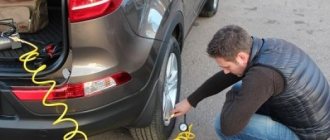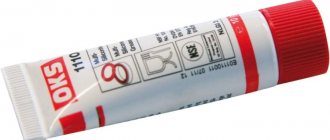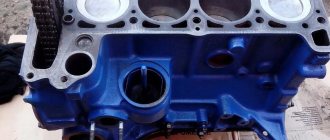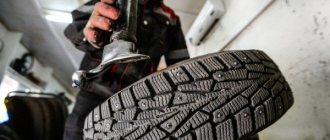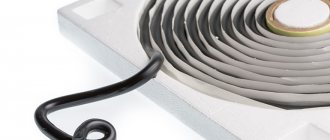Types, purpose and principle of operation of sealants
There are various types of sealants on the market that are suitable for sealing bicycle and car tubes, as well as for repairing tubeless tires. Depending on the composition, the puncture sealant can be as follows:
- Latex. This product envelops the inner surface of the tire, hardens in the puncture area, forming a strong film. This “patch” will prevent the pressure from decreasing excessively.
- With granules or fibers (natural or synthetic). Fibrous compounds (polyethylene, asbestos, paper) fill the puncture in the tire without affecting the rest of the surface.
Most often, tire bead sealant is produced in cylinders filled with the basic composition. Also, such products are produced in metal containers with a brush. Sometimes the sealant comes with a set of a patch and a cloth soaked in degreaser. Based on their purpose, tire sealants can be divided into repair (emergency) and preventive.
Sealants for repairs
It is necessary to use such bead sealants when the tire has already been punctured and urgent tire repair is required. Most compounds operate with a completely flat tire and are introduced through the nipple. Repair sealants most often come in aerosol form with a tube tip, so applying them yourself is easy and convenient. Gradually, due to the increase in pressure, the tire begins to gain volume, restoring its normal shape, and foam is released from the punctured areas. The remainder of the product in liquid form does not always need to be removed from the wheel; most often it is recommended to leave it to prevent new defects.
Preventive
Such products are designed to prevent punctures of tubed and tubeless tires. They are also poured through the nipple, and when the car moves, they are evenly distributed inside the tire under the influence of centrifugal force. If a hole does happen, the pressure in the tubeless tire will remain the same, because the sealant will rush to the hole and seal it. If there is a chamber, the composition will be in the air cushion between the tread layer and the cylinder, working in a similar way.
Some sealants have additional functions:
- reduce the rate of oxidation, increase the service life of the chamber due to increased wear resistance,
- prevent corrosion of cord threads,
- protect tires from overheating and prevent rubber delamination.
The last indicated property is due to the fact that wheels with cameras can heat up due to the presence of an air gap, and the sealant cools the tread due to its low boiling point.
Types of sealants
All sealants offered by manufacturers are divided into two types: sealing and repair. In turn, sealing sealants can be divided into two more types.
The first includes “black” sealants . They are used to eliminate air leakage from the chamber by sealing it from the inside. When applied, “black” sealants dry and form a film that reliably seals the voids between the cord and the tire bead.
The second type of “black” sealants works on a different principle. They independently move to the place of air leak and eliminate the gap due to internal pressure.
Repair sealants serve as a tool for restoring the tubeless layer. They are applied to previously sanded areas of tires. Most often these are the side surfaces. The operation is performed a few minutes before the area is covered with a plaster - this way maximum isolation is achieved. This procedure allows you to reliably eliminate air leaks from a tubeless tire.
Rules for choosing a sealant
To purchase a truly high-quality tire sealant, you need to consider the following recommendations:
- The temperature range of the sealant must correspond to the time of application. Some products crystallize when the temperature drops below zero, so they are not suitable for the winter season.
- Purpose. A number of sealants work against low pressure, increasing this indicator inside the tire; others do not have this function, and therefore must be used without deflating. It is not advisable to use preventive means to install an already punctured chamber: they have less strength than repair ones. You should also make sure that the sealant is suitable for your specific wheel type. On sale you can find compounds that are only suitable for small cars and will not cope with repairing SUV wheels.
- Puncture size. Some products are used to seal holes up to 1 cm, others only work when the hole does not exceed 2-3 mm in diameter. If the holes are too large, it is better to immediately contact a tire shop rather than try to do the work yourself.
- Bottle volume. Up to 300 ml of product is enough to eliminate 4-6 defects or for preventive filling into a small tire. For tires with large dimensions, you will have to purchase several bottles of sealant.
Economical tire sealant: Joe's No Flats, $50.
- Supplied in a convenient bottle that allows you to add it through a removable nipple nipple. It was considered modern until market leader Stan introduced a sealant with a service life of 4 - 6 months.
- Supplied with rim strips in two different widths. If you have narrow cross-country rims, then it is better to buy with a thin tape, as a wide one can complicate the installation and sealing of the tire beads.
- Capable of sealing any hole up to six millimeters in a few seconds.
- Recommended volume: 120 - 180 ml for large wheels, 60 - 120 ml for cross-country tires and 40 - 50 ml for road tires.
- Requires regular addition every six months to a year
- Supplied in 0.5 and 0.125 liter bottles.
How to use sealant
Any tire sealant comes with the manufacturer's instructions, which describe the procedure in detail. For most products, the steps are as follows:
- Remove the wheel from the disk, rim. Remove the object that caused the puncture of the rubber: usually it is a sharp wire or a nail. If it is in the tire, you will have to use pliers to remove it.
- Release all air from the tire. Unfold the product so that the puncture site is in a position convenient for the technician.
- If repairs are carried out in winter, slightly warm up the sealant bottle. You cannot use open fire for this purpose; it is best to place the product in the car interior, where the heater is on, for 15 minutes.
- Remove the spool. Place the tip of the cylinder or the tube that comes with the kit onto the wheel valve and secure it as securely as possible.
- Fill the product with sealant by pressing the valve of the can. The latter should only be located in a vertical position.
- After the tire has acquired the desired shape, disconnect the cylinder from the valve. Measure the tire pressure and, if necessary, bleed the air or pump it up with a compressor.
The first ten kilometers of the journey after the repair must be driven at low speed: this will help the compound to be better distributed inside the tire. After that, if the damage is minor, you can continue to use the wheel, but if the puncture is serious, it is better to get to a repair shop quickly. You need to check the tire pressure again after 10-20 km to make sure there is no overinflation, because some sealants remain active for a long time.
Tips for using sealant:
- eliminating lateral damage in this way is impossible; do-it-yourself sealing is carried out only in relation to the protectors,
- sealants cannot be used if there is deformation of the wheel, there are seals on the disks and other serious defects,
- some sealants contain flammable gases, and when injecting them, you cannot inflate the wheels with air for a certain time,
- It is unsafe to drive a wheel sealed on your own at high speed; it is better to keep the driving speed no higher than 60 km/h or contact a professional for repairs.
Long lasting tire sealant: Effetto Caffelatex, $60.
- This ammonia-free system can resist drying out for a long time. When injected, it foams and thereby helps to quickly treat the entire tire. The kit includes rim sealing tape, nipples and injection device.
- Sealing does not always happen immediately. It is not as sticky as Stan's or Joe's and some UST tire and rim combinations can take quite a long time to seal.
- Unlike other sealants, it is able to seal side wall punctures well.
- Supplied in 1 liter bottles, which is enough to seal at least ten wheels.
How to make your own tire sealant
Some craftsmen make a composition for sealing tires from improvised materials. Since almost all factory sealants are based on raw rubber (rubber), you will need to buy such material and dissolve it in gasoline. It is best to purchase imported rubber that contains a minimum amount of impurities.
Any gasoline that is available will do; it is not necessary to purchase high-octane gasoline. Even kerosene and diesel fuel are suitable, although with gasoline the finished product will be of better quality. You will have to choose the exact proportions yourself.
Next, cut the rubber into small pieces and gradually add gasoline so that the finished product has a semi-liquid consistency. This sealant can be poured inside the tire or, if required, applied to the tire with a brush, similar to a lubricant.
Sealant for tires: what is the specific application
It is probably difficult to find a car enthusiast who does not have to puncture a tire. This phenomenon is extremely unpleasant and it is good if there is a service station nearby where you can drive up with a spare tire and have the tires installed. But there is a simpler option for solving problems - tire sealant . This auto chemical product has become very widespread among drivers in recent years. The reason is ease of use and high efficiency. Tire sealant is a complete replacement for a spare tire, because the product will allow you to quickly and effectively get rid of punctures in tires. It is very important that even in the event of a large puncture, this auto chemical product copes with its “responsibilities” perfectly. But how to choose a high-quality sealant, since there are many types and types of these products on the modern market?
First, it is important to decide what type of sealant is needed. Many products are intended for professional work, and there are some that are exclusively for tire repair. A high-quality sealant is immediately evenly distributed over the entire surface. As soon as any hole appears, it instantly becomes clogged.
You also need to decide on the type and size of the puncture. If the “injury” has formed on the side of the tire, then the preventive composition will not cope with such a nuisance. As for the size of the hole, most compounds help out if the “hole” reaches eight millimeters. If the hole has a larger diameter, the sealant is unlikely to be of any help - the wheel will have to be changed.
The radius of the tire that needs to be repaired also matters. Most sealants are designed for small cars. Therefore, the choice must be made based on the type of tire. If the sealant is equipped with a special sprayer, then “connecting” it with the nipple of a car wheel will be quite problematic.
Another important requirement is that the type of sealant matches the temperature conditions in which the vehicle being repaired is operated. There are a number of imported sealants that are simply not capable of performing their functions in our conditions. At -35 degrees Celsius they can freeze. It should also be taken into account that all sealants are designed not only to seal the tire in case of a puncture, but also to cool it when overheated, which is very important in the summer. Thus, when choosing, it is necessary to clarify whether the product contains the appropriate filler.
Many car enthusiasts actively use sealants in tires that have already been patched using the “cold” method, which is strictly prohibited. The sealant will be a very bad “savior” in such situations.
Very often, when repairing a tire in a car workshop, the technicians remove the sealant from the tire. However, if the device comes into contact with your hands, you must wash it thoroughly with soap and water.
To extend the life of your tires, you need to choose the right puncture sealant. Only in these cases will specialized devices meet all the owner’s expectations.
Sealant for tires: what is the specific application?
Please rate this page
Rating of popular sealants for tire repair
Among the variety of tire sealants, you can get confused: such a large assortment is available in stores. Below we describe high-quality compounds that will help repair a broken tire.
"Anti-puncture"
Anti-Puncture sealant is universal and is suitable for preventing and repairing holes. The packaging is enough to seal ten punctures no more than 6 mm in diameter. The composition is suitable for tubed and tubeless tires. One wheel of 14-15 inches will require 300-330 ml of product, for 15-16 inches you will need 360-420 ml. When repairing SUVs and trucks, you should purchase at least 480 ml of the product.
Wheel sealant Hi-Gear Tire Doctor
One of the most popular sealants, considered ideal for emergency repair of tubeless tires. Hi-Gear Tire Doctor can be used in road conditions; if there is a hole, it will help you get to a car service center. This American product is considered reliable and durable, but if possible, it should only be used to seal small punctures.
Liqui Moly Reifen-Reparatur-Spray
Liqui Moly brand sealant is made on the basis of a rubber solution, excellent for tubeless and inner tube tires. The composition in the form of a spray is odorless, safe for humans and the environment, and can be used even in enclosed spaces. Due to the risk of fire, do not handle the product near an open flame.
Emergency sealant MOTUL Tire Repair
The repair compound of this brand is intended for restoring punctured and cut tires. One cylinder is enough for a 16-inch wheel. When injected, the rubber compound fills existing defects, and the remaining mixture becomes a prevention of new cuts, continuing to remain inside the tire. The sealant creates high pressure, which reduces the risk of a flat tire on the road. The downside of this product is that it causes some imbalance in the wheels, so after repairs it is better to have the car checked at a service center.
ABRO emergency sealant
The sealant is used for car tires and is not suitable for repairing inner tubes of bicycles and motorcycles. It quickly seals small punctures on tires up to 16 inches in diameter. The product can be used for tubeless and tube tires, but the effectiveness when working with the former is much higher. When it’s cold, the sealant needs to be warmed up well, otherwise the quality of the repair will decrease.
AirMan Sealant
It is considered the most popular solution for tires for trucks, SUVs, and large equipment. Its packaging is enough to process a tire with a diameter of 22 inches. The product is suitable for machines where an automatic pressure control sensor is installed. The quality of the Japanese product is very high, the sealing properties are serious, but the cost cannot be called budget.
Aerosol sealant K2 Tire Doctor
Inexpensive tool for repairing tubeless tires in road conditions. Helps to inflate the tire to a pressure of 1.4 atmospheres and get to the service center without any problems. The sealant is available in the form of an aerosol in a convenient container with a hose; working with it is comfortable and easy.
Emergency sealant MANNOL Reifen Doctor
An effective sealant that allows you to seal holes up to 6 mm in diameter. Suitable for old wheels with tubes and tubeless tires. MANNOL Reifen Doctor acts quickly, sets in literally a minute, is safe for steel disks, and does not provoke the development of corrosion. Inside the tire, the sealant will be in liquid form, but upon contact with air it will immediately polymerize, so it can also be used to prevent punctures. The downside of the product is low pressure after repair, the need for additional inflation of the wheel with a pump or compressor. The maximum puncture size for sealing is 6 mm.
Anti-puncture XADO ATOMEX Tire Sealant
The setting time of this product is also minimal - 1-2 minutes, it is suitable for cars, trucks, and other equipment. The price of the sealant is low, but it serves as a temporary remedy until a visit to the tire shop, and the maximum driving speed should not exceed 20 km/h.
Emergency sealant NOWAX Tire Doctor
Latex-based sealant has a temporary effect until a trip to a car service center. After filling, you need to drive at least 5 km at a speed of 35 km/h to distribute the compound over the inner surface of the tire. The sealant will not cope with large punctures, so it is not suitable for holes larger than 4-6 mm in diameter.
Runway Emergency Sealant
Runway sealant is suitable for use on motorcycle, bicycle and car tires. It is sold in a can with an extension hose, the volume of which is 650 ml, which is enough to repair two wheels. Due to the nature of the composition, do not allow the product to come into contact with the skin or mucous membranes!
AIM ONE Tire Inflator
Easy to use, fast acting and effective product. It is completely safe and non-toxic, easily copes with holes and cracks up to 5 mm in size, suitable for trucks, cars and bicycles. The sealant is ideal for use on the road as an emergency solution, although the “patch” it creates will be quite durable.
Continental RevoSealant
The sealant is produced by a concern that produces one of the most famous brands of tires, and is adapted for any car tires. It is based on latex, and there are no harmful additives or toxic impurities. In addition to safety for humans, the sealant is characterized by the absence of a destructive effect on wheels. The composition allows you to do without a spare wheel when carrying out repairs in emergency conditions.
Stan's NoTubes
This American-made product is respected by consumers due to its high quality. It copes well with tire damage, has a more liquid texture than its analogues, so it quickly spreads over the inner surface of the tire. The effectiveness and long service life of the sealant (up to 7 months) are due to the presence of natural rubber and composite microcrystals in the composition.
Orange Seal Bottle Tubeless Tire
The product copes with tire holes up to 1 cm in diameter, eliminating air leakage by forming a “plug”. Made on the basis of latex, it is a thick composite solution with virtually no odor. The sealant is suitable for large cars and trucks. To restore pressure, you need to have a pump or compressor with you.
Bead Sealer Rossvik
Bead Sealer Rossvik is used only for small cuts - up to 3 mm in diameter. It involves applying the composition externally with a brush in 3 layers with intermediate drying with a hair dryer, which is quite a big inconvenience. Typically this sealant is used in auto repair shops.
Holts Tyreweld
Holts Tyreweld brand sealing compound allows emergency wheel repairs to be carried out quickly and reliably. This polymer product is harmless to tires, tubes, wheels, and seals punctures up to 6 mm in diameter.
It is recommended that every car owner who does not have a spare wheel carry the sealant with them. The product will eliminate the need to purchase it and will allow you to safely get to a car service center; in addition, it will be an excellent measure for preventing punctures when used prophylactically.
Do I need to use sealant?
On thematic forums on the Internet you can often find heated debates about whether it makes sense to use sealants for the sidewall. There are many contradictory arguments and examples on this score. Omitting unnecessary considerations, we can say that bead sealants (preventive) are recommended to be used when repairing low-quality or old (with significant mileage) tires and the disc itself with defects. In this case, its tubeless layer adjacent directly to the surface of the wheel rim is leaky, and this is the direct cause of the risk of tire depressurization.
If the car has good new tires installed, especially on a non-bent disc, then the use of sealant is not necessary. And in some cases it is even harmful. For example, if the elastic adjacent rubber layer is very soft, and the sealant takes on a rigid shape after drying, this is very harmful to the tire. In addition, the wheel may become depressurized. This situation is due precisely to the fact that the tire will sit rigidly in its seat, and when driving on a bad road (especially at high speed), the sealant can develop a microcrack through which air will escape.
Some car enthusiasts note that due to the use of sealants, if necessary, it is very difficult to separate the tire from the rim. In fact, such a problem can arise not only due to the use of the mentioned means, but also due to a mismatch between the width of the tire and the rim. Therefore, there are three solutions here. The first (and more correct) is to use the “correct” rims that are most suitable for a specific tire. The second is the use of softer rubber, that is, with a more elastic side. The third is the use of special liquids to dissolve sealants. An example of such a product is the Bead Breaker dismantling liquid from the Tech company (article number 734Q).
As for repair sealants, which are applied after the aforementioned roughening, the situation here is more obvious. If a corresponding repair operation was carried out to restore the tire, then the use of such a sealant is also very desirable. Otherwise, there is no guarantee that the repaired tire will not leak air exactly in the place where the roughening was carried out.
It makes sense to briefly discuss how sealant should be applied to the tire bead. First of all, you need to thoroughly clean the disk (in particular, its end side, which is in direct contact with the wheel rubber) from dirt, dust, rust, peeling paint and other possible damage.
Wheel cleaners
A special cleaner is used to clean wheel rims. It can be acidic or non-acidic. These products wash off bitumen and other dirt well. According to tests, the best rating includes: Tortal Wax, Koch, Liquid Moly Read more
Some car enthusiasts sand the surface of the disc using sandpaper or special sanding brushes placed on a drill or grinder. The same applies to the surface of the tire. It should be cleaned as much as possible from dust, dirt, and possible deposits. And only after that, using a brush (or other similar device), apply mastic to the edge of the sidewall of the tire for its further installation on the disk.
It is also worth paying attention to the condition of the wheel rims and their geometry. The fact is that over time, especially when driving on roads with poor road surfaces, they can be mechanically damaged.
Tire types
Wheel manufacturers predominantly use tubeless tires, which do not have a tube, and they are also distinguished by a radial wheel design - a non-standard placement of threads in the frame structure, which do not cross each other, but are located parallel to each other. In addition to tubeless tires, the following types are distinguished:
- low-profile - ideal for people with an energetic driving style, as they provide the opportunity to accelerate well, improve the quality of driving and get maximum grip on the road. Disadvantages include noise and the inability to drive on uneven surfaces, so holes and high fences can lead to immediate disk failure;
- puncture -free ones are the second most popular for equipping modern cars. Thanks to advanced technology, in the event of a puncture, such tires can travel more than two hundred kilometers at a speed of 90 km/h. The thing is that when creating them, an extended sidewall is used, which protects the tire from bending even with a complete loss of pressure;
- off-road - these are used by drivers who often encounter off-road conditions. Their design, namely the deep and rare tread pattern and the height of the rubber profile, allows them to cope perfectly with poor or completely absent roads, as well as climb steep climbs. However, such tires are absolutely unsuitable for high-speed driving on ordinary flat surfaces, as they “hold” the road terribly and increase the braking distance of the car;
- seasonal - the largest variety of tires, which is divided into three types: summer, winter and off-season. Summer ones guarantee maximum driving safety on wet and dry roads and excellent wear resistance, but under the influence of low temperatures they “tanner” and lose all their properties. In this case, they will be replaced by winter tires, which are softer in composition and have good contact with the road even in the iciest weather. However, with the onset of spring, you should not put off replacing them with summer ones, because as the temperature rises, they begin to wear out quickly. As for off-season tires, they are suitable for warm and favorable climates, since one half of their tread is winter and the other half is summer. In terms of their qualities, they are much worse than both summer and winter tires.
We recommend: Hail dented your car? Find out how to remove dents on the body yourself?
Features of tubeless tires and their design
Tubeless tires absolutely deservedly occupy a leading position in the market, because compared to tube models they have a low probability of damage and the ability to repair them yourself. A number of other features of this type of tire also include:
- the presence of a hermetic layer, which, when a foreign object penetrates, envelops it and thus retains the required volume of air and relieves pressure. This often contributes to the long-term use of such damaged tires by car owners who may not even be aware of the problem;
- the possibility of repair using a special adhesive paste, thanks to which it can be carried out without removing the tire from the wheel;
- special seal that prevents depressurization;
- long-term operation - due to the lack of overheating and lower weight, a tubeless model can serve for a much longer time;
- no friction between the tube and the tire, which reduces the risk of the tire heating up while driving;
- auxiliary shock absorption of discs.
Did you know? Having supplanted tube models, the tubeless type of tire is now installed by modern manufacturers on every car, but was invented only in the middle of the last century. This was due to the advent of higher quality and denser rubber, which allowed for the absence of a camera, which was immediately applied.
Tips for identifying
The selection of tires is always a topical topic for most drivers, since correct decoding of the information printed on the tires will allow them to be used profitably and choose the most suitable ones, and will also greatly facilitate their replacement for the next season. Our tips will help you understand what the different symbols mean, how to visually distinguish high-quality tires, and their characteristics. Let's take as an example the following set of symbols from the bus and give them a designation: 195/65 R 15 91 T XL.
- 195 — tire width in mm;
- 65 - the so-called “profile”, that is, the ratio of height to width;
- R is the radial structure of the tire, not the radius, as it might seem at first glance. There is also a diagonal structure (D), but in terms of its performance indicators it is significantly inferior to the radial one, so now it is practically impossible to find it on the market;
- 15 — disk height in inches;
- 91 — load index. Simply put, this is the maximum permissible level of load that can be applied to one wheel. When choosing tires, you should pay special attention to this indicator, since for trucks an index less than 150 is not allowed. As for passenger cars, this value is almost always not decisive (for example, IN - 91 - 680 kg);
- T - speed scale. This is the maximum acceptable tire speed given the correct pressure and load capacity. This index is designated by different letters, the highest indicator of which is ZR - with it you will travel more than 240 km/h (in this case IS - T - up to 200 km);
- XL is additional information indicating that the tire has a higher load index than other tires of the same type. For example, if the index 91 with the XL mark is indicated on the sidewall of the tire, this means that it can withstand a load of 680 kg instead of the declared 620.
Learn how to make your own anti-skid bracelets.
But not only these symbols are presented on the sidewall of the tire. More detailed and additional characteristics are also required to be deciphered; let’s consider them:
- AS (All Season) - indicates that the tires are designed for driving in any weather, that is, they are non-seasonal;
- RSC (Run Flat System Component) - specially developed tires with advanced Run Flat technology, which allows you to drive without damage at speeds of more than 90 km/h;
- Tubeless (or most often just T) - indicates that the tire is tubeless. If the inscription is missing or you see two Ts instead of one letter, this means that the tire is used only with a tube;
- E - indicates that the tire meets the standards of the Economic Commission for Europe;
- A, B or C - the heat resistance of the tire when driving at high speeds (A is the best indicator).
Instructions
The use of the product is simple, accessible even to inexperienced drivers. The anti-puncture wheel composition has accessible and understandable instructions. First of all, you need to decide on the amount of liquid required (HG5316 480 ml, HG5312 360 ml or HG5308 240 ml).
For cars with a standard diameter wheel (14″/15″), 300-330 ml of sealant is required. With a wider diameter (15″/16″) you will need a little more product - 360-420 ml, and for narrow ones (13″) - 240 ml. Trucks and SUVs will require 480 ml of fluid.
According to the manufacturer, one bottle is enough to treat 1-2 wheels of a passenger car, depending on the diameter and volume of the product purchased.
- Next, you need to perform the following steps if the tire is not punctured:
- Shake the composition.
- Cut off the spout of the bottle (about 6 mm).
- Turn the wheel so that the spool is at the bottom and slightly to the side, unscrew the nipple and bleed the air.
- Insert the spout into the spool, squeeze out the required amount of sealant, according to the dosage.
Tighten the nipple, bring the pressure to working pressure. After repair, you need to drive 2-3 km to evenly distribute the compound on the tire; during the trip you may feel a slight imbalance, which will soon disappear.
If the tire is punctured:
- In the event of a puncture, locate and remove the punctured object from the wheel.
- Follow the instructions for treating an unpunctured tire.
- Inflate your tires to the optimum pressure.
Hi-Gear emergency wheel sealant has similar instructions, anyone can handle it, the main thing is that the container is not frozen, not colder than +15 C, and the wheel is flat before starting repairs. One package is for one wheel. Not recommended for bicycles and motorcycles, because the aerosol is under high pressure and can simply ruin the tire, otherwise these products are identical.
Special harnesses for repairing tubeless tires: cord, rubber and anchor
Special harnesses for repairing a puncture in a tubeless tire are also different:
- cord bundles;
- rubber bands;
- anchor harnesses.
How to repair with a cord harness
The use of such a harness is the most common method of repairing tubeless tires in the field. Composition of a cord harness: a strip of nylon, which is impregnated with glue made from rubber.
Installation of such a harness is done with two awls: spiral and installation. A spiral awl is needed to pierce the puncture site. It is used to turn the tire out and clean it of dirt. And with the second, installation awl, the already cleaned and expanded area is pierced and a tourniquet is inserted. After inserting the harness, the first spiral tire must be pulled out, and the installation awl along with the harness must be inserted even deeper. Then, the second awl is also pulled out, but the tourniquet remains. The tourniquet will stick out from the cut in the tire. The protruding part of the harness must be cut off.
Did you know that there are chains and there are snow bracelets? The difference between chains and snow bracelets is that in order to put on the bracelets, you do not need to jack up the car.
This method has a number of advantages:
- fast;
- effective;
- easily;
- The tourniquet lasts about 6 months.
How to repair a tubeless camera with a rubber band
The quality of rubber is better than cord. And the price of a rubber band is higher. The principle of working with such a harness is slightly different.
When working with a rubber band, you should not use an awl-rasp, because it can damage the material of the band during installation into the tire.
Before installing the harness, it must be lubricated with glue, preferably one recommended by the manufacturer of the harness.
How to repair a tubeless tire with an anchor
There is a harness that has an anchor-shaped patch at the end. The principle of installing such a harness is similar to the previous ones. This tourniquet clogs the hole and is glued to it from the inside with a patch. In order for it to stick, after inserting the tourniquet, you need to pull it back a little.
To carry out such work on sealing tires, you need to buy a cutter with a diameter of 6 mm for inserting an anchor. Using an anchor harness is the most reliable way to repair tubeless tires.
None of the types of harnesses are used for repairing tubeless tires. Repairing punctures yourself is a temporary fix. If you plan to use the car over a long distance, then it is better to go to a tire shop and get it done efficiently. If the tires cannot be repaired, you will have to buy new ones. To choose the right tires, you need to learn how to decipher the tire speed and load indices.
